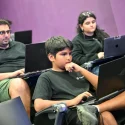Singapore – When Ms Kelly Tay, 38, feels anger and frustration surging within her when her two young children misbehave, she takes a step back to pause and calm herself by looking at her children’s hands.
“When I look at how small my kids’ hands are compared with mine, it is a visual reminder that their brains are not fully developed yet,” said the mother of a four-year-old son and a six-year-old daughter.
“So, I have to calm down first and lend them my calm. If I am shouting or raging, they will shut down or cry even more.”
Ms Tay is a certified parent educator who works with Asian parents to “break generational cycles of fear-based discipline and embrace respectful parenting”.
She teaches her children what is wrong with their actions or behaviour only when everyone is calm – she says children are unable to really listen or learn if they are in distress.
The first steps towards disciplining her children are to regulate her own emotions and to learn more about children’s development, said Ms Tay, who does not use physical discipline.
Ms Lin Xiaoling, director of research and advocacy at the Singapore Children’s Society, said that when children are fearful or in distress, the emotional part of their brain is activated and this blocks access to the part of the brain that facilitates thinking and learning.
This means that even well-intentioned discipline fails to achieve the desired learning outcomes if the child is too fearful or distressed.
While physical punishment may get the child to stop their wrong behaviour momentarily, they do so to avoid punishment, rather than because they understand right from wrong, Ms Lin said.






